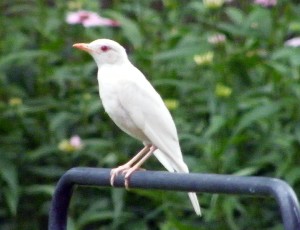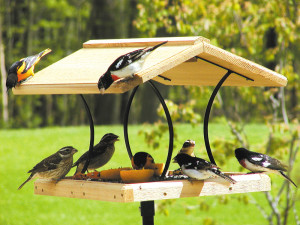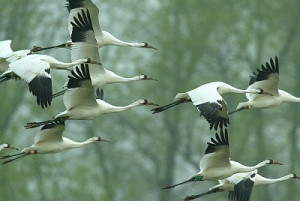Want to set up a hobby that promises excitement AND benefits every time you have fun? Well, you have come to the right place! Birdwatching promises to bring you the “goods” every time you gather your gear – which can amount to just you scanning and observing. It’s that easy to be an ecologist and to do your part to conserve bird species and important wildlife habitat. Birders know that the element of surprise is always just around the corner… or in the nearest holly bush or apple tree. There is a rustle in the branches and an indigo bunting lights up your day. Ever see an albino robin or watch a pair of cardinal fledglings trying their wings? You will, once you take the time to really observe your surroundings with the intent of seeing a bird.
Keep a diary of the following:
- Species of bird seen. Record these on a still camera, video or by simply jotting down what bird you have observed.
- Time of day and season (early spring, late spring, summer, early fall, fall and winter) Include any unusual sightings as well. Local bird clubs will want to hear from you!
- Population count for each bird species.
What to do
Birding is one of those hobbies that requires nothing but a desire and the ability to sit and wait. The first step is to identify bird habitat – where you are most likely to see the birds in action. Birding is local, regional, “timely” and seasonal. That means you will see certain species doing certain things (foraging, territory collecting and nesting) during predictable times of the day and year.
Depending on where you live – urban, rural or suburban, coast, desert or mountain – the locale and its available resources and fixtures will dictate what species will be visiting.
Even urban areas provide resources for songbirds, waterfowl and birds-of-prey. A city-dweller can affix a seed tray or nectar feeder to a window and watch for titmice and hummingbirds. Urban park systems are stopover ports for migrating birds and a variety of waterfowl descend to their ponds. Keep an eye to tall buildings to see soaring red-tailed hawks and dynamic peregrine falcons.
Suburbanites have intriguing options. Set out bird feeding stations including mixed seed, sunflower, suet and nectar feeders. Always provide a water source as well. Avoid large expanses of lawn (and never apply toxic chemicals), and be sure to break up your backyard into resources with islands of shrubs and other plantings. Here are some bird friendly flowers and plants —honeysuckle, holly, viburnum, crabapple, dogwood, bergamot, hosta and butterfly bushes. Provide nesting spots and cover trees such as yew, arborvitae and other evergreen varieties. Once you set up this “bird” habitat you will be amazed at the variety of songbirds that visit your yard.
If “rural” includes your neck of the woods your birding possibilities expand. This is also true for those in coastal, mountain or prairie areas. You can provide the same resources as the suburban birdwatchers – set out water sources and feeding stations. Rural and wooded zones are home to a tremendous ecosystem. Keep a log of wild turkey, bobwhites and gallinaceous species, birds-of-prey including owls, hawks and eagles, pileated woodpeckers, thrush, warblers, orioles, bluebirds and so many more!
If you are a farmer with a hay field consult your local Audubon center or conservation society. Hayfields are a critical breeding ground for endangered field birds such as bobolink and killdeer. Leave center islands uncut and ensure a large swathe of grass is left along the perimeter of fields.
Coastal homesteaders will categorize a wide variety of shore and pelagic birds. Warmer Gulf zones will see gannets, brown pelicans, frigate birds, terns, albatross, boobies, sanderlings and sea ducks. Other hotspots for shore and ocean birds include stretches of the Pacific, Chesapeake, Eastern shoreline and even central lakes regions. The species recorded will be determined by the migration times. Be sure to check these migration maps to ensure best viewing during peak times.
Storms, weather patterns and other environmental aspects influence the times and peculiarities of migration tracks. Birds flock into hotspots at irregular moments in varying numbers. These migration tracking websites provide you with the latest updates – you don’t want to miss out on the Whooping Cranes soaring into the Aransas National Refuge!
The United States, and both the North and South American landmasses, are home to four internationally significant flyways. Learn more about them to witness the fantastic flow of birdlife through your area. There is a flyway that passes over every “band” (north south) of the US.
- Atlantic Flyway (sea and shorebird exodus zone – home of the Chesapeake Bay)
- Mississippi Flyway (called the “Sea of Birds”)
- Central Flyway (famous for it’s Sandhill Cranes)
- Pacific Flyway (critical shorebird habitat area stretching from Alaska to Mexico)
Here are a few resources!
- Waterfowl (ducks, loons, geese): Ducks Unlimited offers regularly updated maps that pinpoint what species, population and weather reports are in effect in a specific area. This detailed map is a great resource for birdwatchers recording waterfowl populations.
- The Cornell Lab of Ornithology “Bird Cast”: The ornithologists at Cornell University use good old-fashioned observation and population records with high-tech tracking to get accurate reports of migrating birds. The information is used to provide
scientists with crucial population and conservation information as well as welfare impacts caused by human activity. The records prevent bird suffering by proactively making “decisions for placement of wind turbines and identifying nights on which lighting of tall buildings could be reduced to prevent the deaths of millions of birds.”
- Audubon’s “Flyways of the Americas”: This interactive and detailed online map illustrates each of the four flyways (Eastern, Mississippi, Central and Pacific). Click on each area to learn more about the spring and fall migration patterns, which birds are the celebrities that draw in the birdwatchers and why these habitats are important.
What you can do
Record in your birding log book the species and population of the birds visiting your area. Log into the Audubon, Cornell or conservation departments and organizations in your region. Many of these groups rely on the information provided by local birding enthusiasts. The records you collect are crucial to monitoring habitat, environmental influences and human activity on the preservation initiatives. Join your favorite organization and become a field volunteer.
Birdwatching is a wonderful hobby that inspires us, and that allows each of us to perform a beneficial action to help conserve wildlife! When birders provide the habitat, knowledge and resources to set-up a powerful foundation for conservation, everyone wins!
The Audubon society reminds us that we can make a difference. “We’re in a race against time — to give birds a fighting chance in a changing world.”



